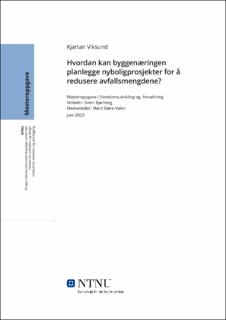| dc.description.abstract | Bygg-, anlegg- og eiendomsbransjen er den største kilden til avfall i Norge i dag. I 2019 leverte nybyggprosjekter avfallsmengder i området 50-60 kg/m2. Reduksjon av råvareuttak og redusert avfall vil kunne være en bidragsyter fra bygg- og anleggsnæringen for å begrense klimaendringene. Politikken som føres i dag for å bøte på utfordringene er å prioritere i tråd med avfallspyramiden. Grunnprinsippet i avfallspyramiden er avfallsreduksjon gjennom å forbruke mindre, dernest ombruk av materialer. Målsetningen er å oppnå en materialflyt hvor råvarer forblir i en sirkulær prosess, og avfall som går til deponi reduseres til et minimum.
Målsetningen for denne studien har vært å undersøke hvordan byggenæringen kan planlegge for å redusere avfallsmengdene på byggeplassen i nyboligprosjekter. For å undersøke påvirkningsmulighetene, har det blitt brukt en kombinasjon av litteraturstudie og semistrukturerte dybdeintervjuer med et utvalg informanter fra flere deler av byggebransjen.
Litteraturstudien viser at det er flere faktorer som påvirker avfallsreduksjon i nyboligprosjekter, hvor prosjektering av materialer og planlegging av logistikk er to av mange elementer. I tidligfase kan det være nyttig å inkludere avfallsreduksjon som et av målene for prosjektet. Valg av materialer bør gjøres med hensyn på at byggematerialene er resirkulerbare eller kan gjenbrukes, samt å unngå materialer har høyt avfallspotensial. Godt planlagt logistikk er også viktig for å minimere avfall. Digitale verktøy som BIM kan også bidra til å optimalisere design og materialbruk for å minimere avfall.
Informantene fra ulike deler av byggebransjen opplyser at det er flere hindre for avfallsreduksjon. Manglende kunnskap om avfallsreduksjon, økonomiske insentiver for å bruk mindre materialer og ressurser for oppfølging pekes på som viktige hinder. Imidlertid viser intervjuene og litteraturen at teknikker, valg av materialer og digitale verktøy kan bidra til mindre avfall. Økt samarbeid med aktørene og kravstilling i innkjøpsprosesser med leverandører og entreprenører kan sette søkelys på avfallsminimering. For eksempel kan materialvalg som kan demonteres, resirkuleres eller gjenbrukes velges for å minimere avfall, etter prinsippene for reversible bygg.
Samarbeid og kravstilling i kontrakter med leverandører og entreprenører kan også bidra til avfallsreduksjon. For eksempel kan kontrakter inneholde krav om at entreprenørene skal rapportere om mengder og typer avfall som genereres under byggeprosessen, og at de skal samarbeide med andre aktører i prosjektet for å redusere avfallsmengdene. Miljømerking kan også være nyttig for å sette et felles måltall for maksimal mengde avfall i byggeprosjekter.
Det overordnede funnet fra denne masteroppgaven er at kultur for avfallsreduksjon er den viktigste faktoren for å oppnå avfallsreduksjon i nyboligprosjekter.
Videre arbeid bør undersøke hvordan byggenæringen kan planlegge reduserte avfallsmengder i et livsløpsperspektiv og hvordan redusere avfallsmengdene i hele verdikjeden. | |
| dc.description.abstract | The construction, infrastructure, and real estate industry is the largest source of waste in Norway today. In 2019, new construction projects generated waste quantities in the range of 50-60 kg/m2. Reducing raw material extraction and waste can contribute to mitigating climate change through the construction and infrastructure sector. The current approach to addressing these challenges involves prioritizing in accordance with the waste hierarchy. The fundamental principle of the waste hierarchy is waste reduction by consuming less, followed by material reuse. The goal is to achieve a material flow where resources remain in a circular process, and waste sent to landfills is minimized.
The objective of this study has been to examine how the construction industry can plan to reduce waste quantities at construction sites in new housing projects. To explore the possibilities for influence, a combination of literature review and semi-structured in-depth interviews with selected informants from various parts of the construction industry has been employed.
The literature review indicates several factors that influence waste reduction in new housing projects, with material design and logistics planning being two among many elements. In the early phases, it can be beneficial to include waste reduction as one of the project's goals. Material choices should be made considering their recyclability or reusability, while avoiding materials that have high waste potential. Well-planned logistics are also crucial for waste minimization. Digital tools like Building Information Modeling (BIM) can optimize design and material use to minimize waste.
Informants from different parts of the construction industry highlight several barriers to waste reduction. Lack of knowledge about waste reduction, economic incentives to use fewer materials, and resource constraints for follow-up are identified as significant obstacles. However, interviews and literature demonstrate that techniques, material choices, and digital tools can contribute to waste reduction. Increased collaboration with stakeholders and setting requirements in procurement processes with suppliers and contractors can focus on waste minimization. For instance, material choices that can be disassembled, recycled, or reused can be selected, following the principles of reversible buildings.
Collaboration and contract requirements with suppliers and contractors can also contribute to waste reduction. Contracts can include provisions for contractors to report on the quantities and types of waste generated during the construction process, as well as cooperate with other project stakeholders to reduce waste quantities. Environmental labeling can also be useful in setting a common target for the maximum amount of waste in construction projects.
The overall finding from this master's thesis is that a culture of waste reduction is the most crucial factor in achieving waste reduction in new housing projects.
Further work should explore how the construction industry can plan for reduced waste quantities from a life cycle perspective and how to reduce waste throughout the value chain. | |
